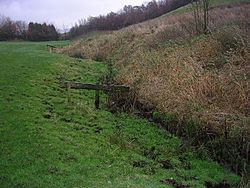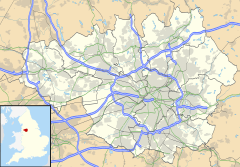Thorp Mill, Royton facts for kids

Landscape around Royton, showing the River Irk
|
|
| Cotton | |
|---|---|
| Carding | |
| Location | Thorp, Royton, Lancashire, England |
| Owner | Ralph Taylor |
| Further ownership |
|
| Coordinates | 53°33′58″N 2°08′09″W / 53.5660°N 2.1358°W |
| Construction | |
| Completed | 1764 (Conversion from cottages) |
| Demolished | Reverted to cottages before 1800 |
| Carding Equipment | Yes |
Thorp Mill in Royton was a very important building in the history of cotton making. It was built in 1764 and is thought to be the first cotton mill in Lancashire to use water power. This mill played a big part in changing how people worked and lived in the area during the Industrial Revolution.
Contents
Thorp Mill: A Pioneer Cotton Mill
Thorp Mill was located at Thorp Clough in Royton, England. It was built by a man named Ralph Taylor. He bought three small houses and turned them into a mill. This mill was special because it used the power of water to run its machines.
How Thorp Mill Began
In 1764, Ralph Taylor started Thorp Mill. It was a carding mill. Carding is a process where cotton fibers are cleaned and straightened. This prepares them for spinning into thread. The mill got its power from a water wheel. This wheel was turned by water from Thorp Clough. Thorp Clough is a small stream that flows into the River Irk.
The mill operated for some years. However, it closed down in 1788. The owner at that time, James Taylor, put the mill and its machines up for sale. It was advertised again in 1792. After this, the buildings were changed back into ordinary houses. Later, these buildings were taken down. Today, a blue plaque marks where the mill once stood.
Royton's Transformation: From Farms to Factories
Thorp itself is an old village located higher up the clough. It is the oldest settlement in Royton, Lancashire. The success of Thorp Mill led to more mills being built nearby. This started a big change in the area.
The Rise of the Factory System
More and more people moved away from farming. They started working in the new factories. This change is called urbanisation. It means that towns grew bigger as people moved from the countryside to live near the factories. The way people lived and worked changed a lot. This is known as socioeconomic transformation.
The new factory system caused Royton's population to grow very quickly. In less than 100 years, the number of people living there increased tenfold. It went from 260 people in 1714 to 2,719 people by 1810. This huge growth was because of the textile manufacture during the Industrial Revolution. By the mid-19th century, Royton had become a busy mill town. A mill town is a place where most people work in textile mills.


